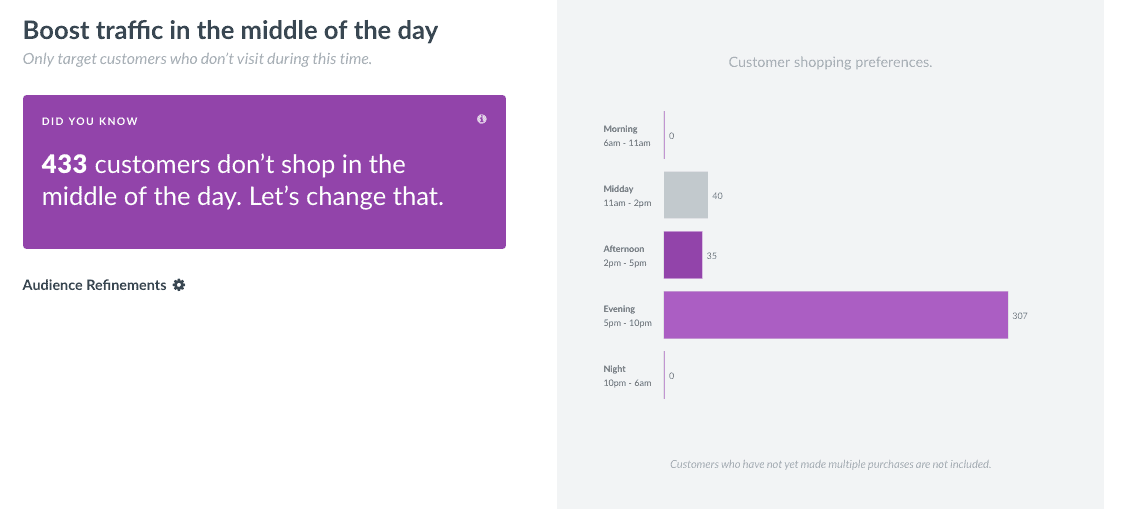Targeted and segmented campaigns can drive or change customer behavior. For example, if you are opening a new pizzeria, you can build a segmented list of customers who live within a 10-mile radius from the new location and send them a personalized campaign with information and a discount during the grand opening.
The more data you have around your best customers, the easier it will be to engage them by building relationships that will grow your business. In this post, we’ll review what segmentation is, and different ways you can use it to engage your restaurant customers.
What is segmentation?
Capturing data to understand who your customers are will help you easily send personalized and segmented campaigns, which will enable you to engage customers in ways you never imagined possible. Segments are a way to “bucket” groups of customers who share behavioral or spending traits. For example, you can use segments based on a customer’s geographic location, favorite menu item, visit frequency, average check size, lifetime value, and more.
Once you have this data from your customer engagement platform, you can easily create targeted marketing campaigns using data-driven segments. Because the segments are pre-built for you using the data you already capture about your customers, you simply select a segment, then create a personalized and automated campaign to reach the right customer at the right time. The best part is, you can measure the impact in real revenue, not just vanity metrics like the other guys give you.
Segmented campaigns will encourage your customers to take actions that can grow your revenue and help you thrive in a competitive and challenging environment. Now. let’s explore the different ways you can change customer behavior by using segmentation.
Boost traffic in the middle of the day
You can use segmentation to target customers who don’t visit during certain times of the day that may less busy than others. For example, in your data, you can see exactly when customers visit and don’t visit and use that information to send a targeted campaign to change that behavior by driving more visits to the less highly trafficked times of the day.

By looking at customer behavior, you can use a segmented list of customers who don’t visit during a certain time of day and send them personalized offers if they visit within a certain time frame. Think about a coffee shop offering a mid-afternoon coffee happy hour. This tactic will not only bring more customers in at a less busy time of day, but it can also increase your incremental revenue by driving an additional visit which also can increase their lifetime value over time.
For example, Elephants Deli wanted to get their daily weekday breakfast and lunch customers to visit on the weekend. They wanted to change customer behavior to visit on a different day of the week (the weekend) and promote brunch at their Corbett Ave. location.
Based on their week-part customer data, Elephants Deli decided to send a targeted day-shift offer to change customer behavior and promote brunch to their weekday customers.
After the campaign was sent, Elephants immediately saw a spike in their weekend brunch traffic at the Corbett Ave location increasing it by 43% over the previous month. They also saw a 50% increase in their customer loyalty member sign-ups. You can read more about their success in this case study.
Boost traffic based on location
There are several reasons why you may want to send a segmented campaign based on a customer’s location. For example, you may want to increase foot traffic at an underperforming location. Or, you may want to promote a new location you just opened. Segmented campaigns can help you engage customers at the right time, based on where they work or live.
Sometimes there are things going on that are only relevant to a specific location like a new menu, new opening hours, or a special event. You can use segmented campaigns to engage customers who frequent that location and encourage them to visit more and spend more, with a personalized message that brings them through the door.
If you close a location, you can get ahead of potential negative reactions by letting your regulars know that you are closing a location and redirect them to another one, nearby. You could also cross-promote traffic from nearby locations to give an underperforming location the boost it needs.
Boost traffic based on spending habits
Targeting your VIP customers who visit and spend the most in a personalized and targeted way can increase their check size. For example, you can send a segmented campaign based on visit frequency and favorite menu item. If you have 300 customers who visit often and love your pasta dishes, you can send them a campaign with a 15% offer on your new pasta special. This will not only increase their visit frequency, but it can also encourage them to spend more when they are at your restaurant, especially if the price of your new pasta dish is slightly more expensive than the others.
You can also win back customers who stopped visiting or who began spending less than they used to. For example, you can send a 15% off incentive to bring customers back through the door. Capturing the right data will enable you to easily send segmented campaigns to increase a customer’s average check size.
Wrap up
By capturing the right data, you can use segmentation to supercharge your marketing campaigns. You can send segmented campaigns based on visit frequency, location, spending habits, and more. Use Thanx to build automated campaigns that reach the right customer at the right time and keep your revenue going up, up, up.